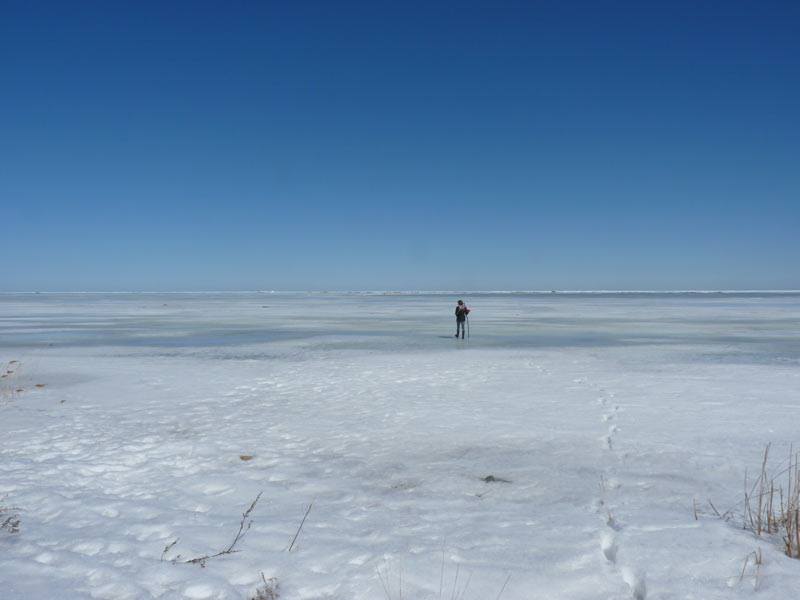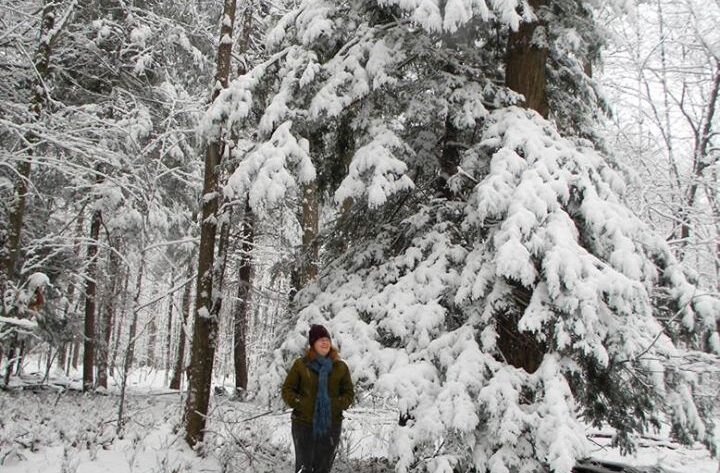As the Wheel of the Year continues to turn, we find ourselves once more in the time of darkness and cold; the time of the brown and the gray; the time of the Winter Solstice. The Winter Solstice, happening around the 21st of December, represents the longest night and shortest day for those of us in the Northern Hemisphere. It marks the real start of winter, which continues until the Spring Equinox. And while this is a time of challenge and struggle for many, I like to think of this time, like all times, represents an opportunity to turn inward, to examine our inner worlds and our inner home lives, and to again seek methods of sustainable practice and action. So here are some spiritual and sustainable practices that you can practice around the Winter Solstice:

Winter walking. I think that one of the challenges we face as a culture in terms of sustainable action is a disconnection with the natural world–especially the natural world in all her forms and in all of her seasons. One of the best ways of reconnecting is to see the beauty and mystery in each day, regardless of the weather. Because of this, I have worked hard to spend a little time outside each day and an extended period of time at least once a week outdoors, regardless of the weather. I make it a point to go on “winter walks” in different types of weather. If you plan on engaging in this practice, invest in some good cold-weather gear. Good wool socks, sweaters, and long-johns, good hats and gloves, and multiple layers of warm clothing will make walks outside enjoyable for you and any others who choose to join you. The key, especially when exposing others who are maybe not used to the winter cold, is to encourage them to dress warm.
I find the time around the Winter Solstice strikingly beautiful–the grasses have died back but are still gorgeous in shades of brown, the landscape shows things hidden with summer foliage. Usually here, its usually too early for snow before the solstice, so the browns and deep reds and grays dominate the landscape. The conifers hold the promise of spring in their greenery. If there is snow, the patterns of animals, usually invisible in the summer, are now revealed. Once the deeper cold of January sets in and our lakes freeze over, I also very much enjoy lake walking (see photo above). You get to commune with the water in a different way.
Regardless of how you choose to winter walk, experiencing this beauty, and sharing it with others, can help us build a deeper awareness and connection to the world (and I think that gives us the underlying impetus for sacred and sustainable action).

Make some winter crafts, medicine, and ritual objects. The Winter Solstice and the dark times provide us an excellent time to practice various bardic arts, especially those of a physical nature. The Winter Solstice is my favorite for finishing up my tinctures created earlier in the season and making medicinal salves for use for the upcoming year. I also like to make big batches of laundry soap and candles. I’m making time also to make my own bars of regular soap after having some fantastic lessons this past year. This is also the time when I make smudges and incense. The idea here is that the more you can make and provide yourself, the more energetically connected you are, the more fulfilled you are (because you are providing some of your own needs), and the less drain you are creating on the system as a whole. This is especially true if you mindfully source anything you don’t have to make your various home goods and crafts.
Alternative gift giving. I wrote about thinking for meaningful alternatives to typical consumerist holiday practices before; it is presented in more detail here. But I again want to encourage readers to think carefully about what needs to be bought, and what can be repurposed; to see the holidays not as a time of excess and spending, as so many now do, but one where we can use creative thinking for meaningful change. For my friends and extended family, I’ve taken to giving people things from my garden–a small bag of sundried tomatoes or a wonderful rhubarb-orange summer solstice jam really is a gift from the heart. One of the things my family has been conscious of doing for some time now is engaging in a “secret santa” gift exchange. Each person gets one other person’s name and a list of things they would like; only $50 can be spend total on the gifts, but any handmade/repurposed gifts are welcome in addition. We also use either re-usable wrapping paper or junk mail/papers to wrap all gifts. This alternative gift giving does a few things–it allows everyone to buy and gain less stuff, and the stuff that is purchased is purchased to fill a need. The gifts are meaningful because they are heartfelt and useful because they are some of what was requested.
Explore alternative lighting and have “candlelight evenings.” It is possible for nearly everyone to explore alternatives to electric lighting during this dark time. I like to have what I call “electricity-free” days where I live more naturally and in rhythm with the earth (and use a lot less resources). I do keep the power on for running my refrigerator, flushing the toilet, and making sure my pipes don’t freeze. But other that, I switch to oil lamps and candles and explore activities that can be done without computers, phones, televisions, and electric lighting. I like to have candlelit evenings when spending time with my family members around the holidays if at all possible–doing this as a group makes a candlelit evening all the more special. We can play games, tell stories, entertain each other. We might even do some woodstove cooking rather than turn on the range. This is a nice addition to the “meaningful gifts” idea above for family time while engaging in more meaningful and mindful living.
Oil lamps can be found fairly cheaply at antique sales and the like, they are easy to use, and they make wonderful lighting (you can even read by them); you do want to be careful what kind of oil you purchase for them (mine were kerosine when I bought them, but now I switched out the wicks and have most of mine burning vegetable oil. Kerosine is very smelly and is a fossil fuel). A single oil lamp is worth about three good candles in terms of light and they are extremely efficient. You can also make your own oil lamps (see instructions on the web here). Beeswax candles are much longer-lasting and sustainable than paraffin ones, although any candle will put out light.

Garden planning and seed starting. One of the other wonderful activities you can do this time of year is to take stock in your seeds, to order or trade for new seeds that are needed, and to plan the garden for the next season. Even if this is your first year, now is a great time to think about what you might do when you can break ground in the spring, or put in a few pots of herbs, or plan your dream growing space. If you want to start all of your own seeds, this also requires some planning and foresight…in my bioregion, I usually start the first of my seeds as early as January. I have a few good posts to help you get started: Seed Starting and Garden Planning: Reasons to Start Seed, Seed Research, and Seed Starting Setups; Sowing the Seeds of the Future: Spiritual Insights on Seed Starting and Growth; Seed Saving, Heirloom Seeds, and Sustainability.

Indoor composting (vermicomposting). Another thing you can do to build more sustainable practices is start an indoor composting bin and start creating some great soil and getting to know earthworms and their activity in the process. I have instructions on how to start such a bin and some spiritual insights from the vermicomposting process.
Home energy audits and actions to seal up the home. Because the cold is blowing in, you might take this time to do an energy audit of your house/apartment and find ways to make your home more airtight and more efficient. The EPA suggests that anywhere from 5-30% of energy can be saved with a home energy audit and taking action. This is a perfect thing to do in the dark months, and the colder it gets out, the easier it is to figure out where the cold spots are. There are lots of instructions online about how to seal up your home better–here’s one that I used to do my own energy audit. But you don’t need anything fancy to do such an audit.
I am working on my own home energy audit this winter–I have several rooms that I don’t heat in winter because they currently aren’t in use, and I’ve been working to seal them up, insulate uninsulated lightswitches, and prevent heat loss from under/near doors and windows. I’m also working to add throw carpets to my cold floors that sit on the slab foundation in my house to help with my cold feet. I can already see a difference in the warmth of my home from these small changes.
Introspection and meditation. A final suggestion for winter solstice activities–take the opportunity to spend some time in introspection and meditation. Daily meditation on various themes can lead to amazing insights–I do discursive meditation daily as part of my AODA practice, and often find myself meditating on phrases or concepts from herbalism, nature-based writers like Wendell Berry, or permauclture designers. Spending time with yourself during the winter months can lead to a blossoming of light and life within.



Burning vegetable oil in a lamp! Ha! I never would have thought of that (and I lived off the grid for 5 years and relied on kerosene). What kind of wick do you need, and is a particular type of veggie oil better?
[…] began this series of posts with examining sustainable actions for the winter solstice. Today’s post celebrates the current holiday–the spring equinox–and suggests activities for […]